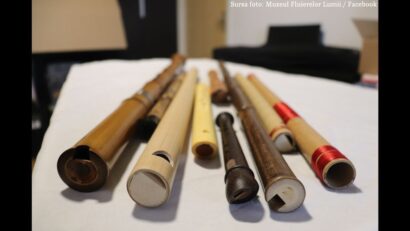Architect Virginia Andreescu Haret
Virginia Andreescu Haret is known as the first woman architect of Romania

Christine Leșcu, 20.08.2016, 14:00
The buildings she designed can be identified today amidst the many heritage buildings of Bucharest, which are genuine works of art, although many have fallen into dereliction. Virginia Andreescu Haret was born in 1894 into the family of the great Romanian painter Ion Andreescu, being the daughter of one of his brothers. So, her propensity for arts came only naturally.
Achitect Răzvan Lăcraru refers to her early life: “ Virginia Andreescu was the niece of the famous Romanian painter Ion Andreescu. She was raised in an artistic environment, in a house full of her uncles paintings. In 1912 she was admitted to the Higher School of Architecture, obtaining the highest mark. In parallel, she attended the Faculty of Fine Arts. She was thus the first woman in Romania to receive a degree in architecture. One of her colleagues was Henrietta Delavrancea Gibory, the daughter of writer Barbu Delavrancea, who graduated later.
Because of the war, Virginia Andreescu could not complete her architecture studies and start work in the domain, being forced to work as a nurse. Following the end of the war, she resumed her studies, which she completed in 1919. Her graduation project was awarded a prize by the Ministry of Education. That was just the beginning of a career that would span 30 years. Architect Virginia Andreescu worked on no less than 130 buildings. However, her first project, made as part of her graduation exam, marked the beginning of a career devoted to building schools.
Architect Răzvan Lăcraru: “Her project was on building a school of fine arts. She would later pay more attention to designing school buildings. She had a significant contribution to designing most of the standard school buildings erected across Romania. Later, during her eclectic period, she also worked on high-school projects, such as the extension of the Sincai High-School or the building of the Dimitrie Cantemir High-School in Bucharest.
Apart from these well-known high schools, Bucharest boasts other buildings designed by Virginia Andreescu, such as two apartment buildings located in Rosetti Square and on Victoria Road respectively. The latter is the first building with apartments sold at affordable prices, which was built by a state –owned company in order to help public servants and workers purchase their own property. Another notable building is the Palace of the Romanian Youth Society, located close to the Dambovita River Quay, and also close to the Cismigiu Park. Other buildings designed by Virginia Andreescu Haret can be found in the posh Cotroceni neighbourhood.
Quite a few of her projects were carried through jointly with her husband, construction engineer Spiru I. Haret, the nephew of the great scientist Spiru Haret.
Răzvan Lăcraru has more on the style of those architectural projects: There is no clear-cut statement Virginia Andreescu Haret made about her favourite architectural style. She designed her own house, on Intrarea Spătarului street in Bucharest, in the eclectic style with neo-Romanian elements. Later on, when she designed her own villa, which can be found on Lascăr Catargiu Boulevard, she adopted the Art-Deco style with modernist influences. She was always a personality of her time, but Id rather say she opted for the Art Deco style, with slightly modernist elements. “
Virginia Andreescu Haret also designed buildings in other cities of Romania. In Govora Spa, in Valcea County, she designed the Parc cinema hall and the Casino. Throughout the years, she consolidated her career, being appreciated both for the private and public buildings she designed. Virginia Andreescu Haret worked for the Historical Monuments Committee between 1918 and 1921, then for the Public Education Ministry between 1921 and 1947. In 1953 she became a member of the Union of Architects of Romania. Virginia Andreescu Haret died in Bucharest in 1962.





























